Coastal Reservoirs: Floodwater Development and Disaster Mitigation
VerifiedAdded on 2021/06/16
|26
|7441
|25
Report
AI Summary
This report, titled "Coastal reservoirs for floodwater development and flood disaster mitigation," examines the potential of coastal reservoirs as a solution to water scarcity and flood management challenges, particularly in Australia. It begins with an abstract highlighting the increasing population along coastal regions and the associated pressures on water resources. The introduction emphasizes the global water crisis and Australia's specific issues with declining rainfall and runoff. A literature review explores the harnessing of stormwater from coastal reservoirs, the impacts of climate change, and the levels of water recorded in reservoirs. The concept of coastal reservoirs is defined, and their design considerations are discussed. The report also touches upon the importance of reservoir location and integration with water treatment processes. The paper underscores the need for innovative water management strategies like coastal reservoirs to address the growing water scarcity, climate change, and flood-related disasters.
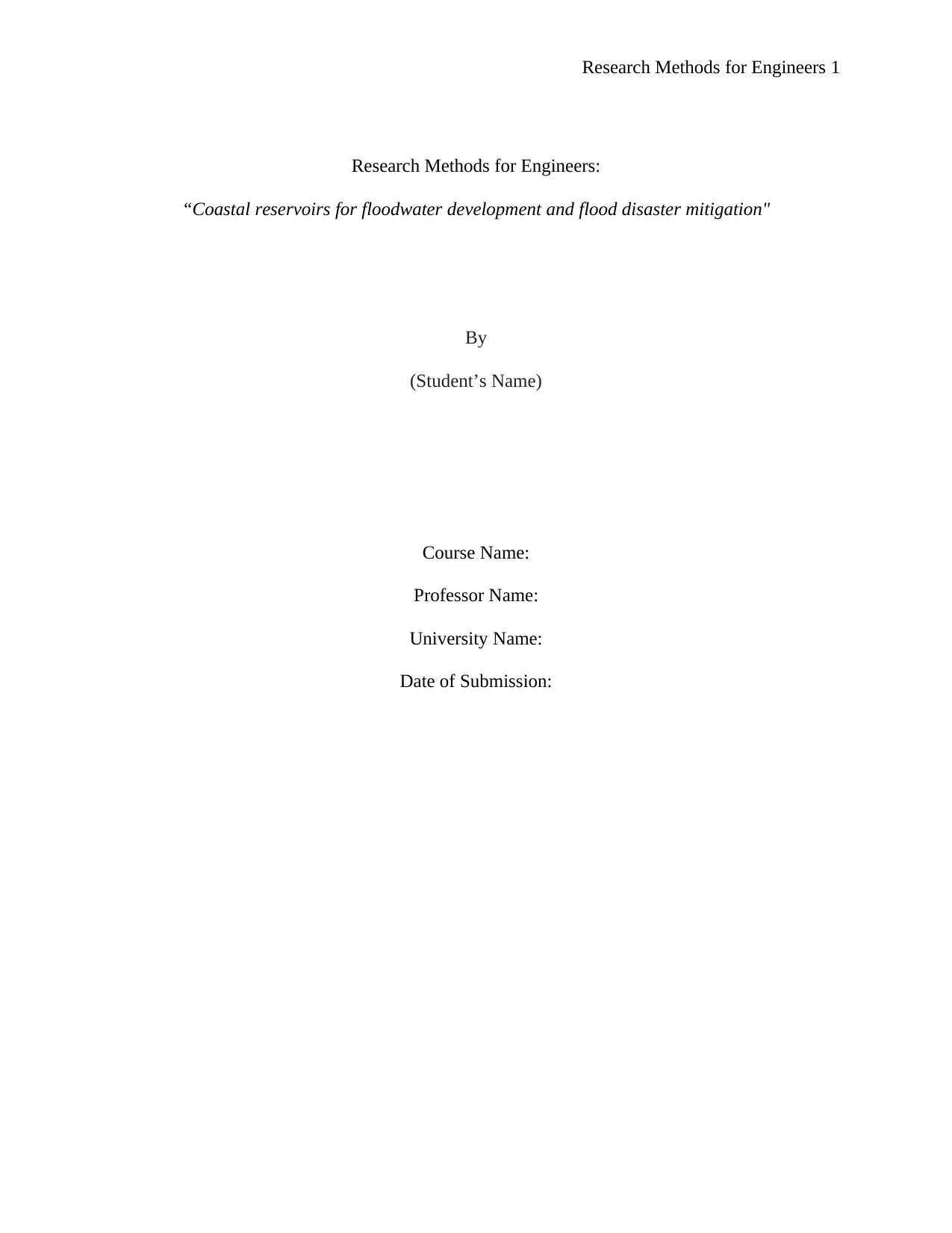
Research Methods for Engineers 1
Research Methods for Engineers:
“Coastal reservoirs for floodwater development and flood disaster mitigation"
By
(Student’s Name)
Course Name:
Professor Name:
University Name:
Date of Submission:
Research Methods for Engineers:
“Coastal reservoirs for floodwater development and flood disaster mitigation"
By
(Student’s Name)
Course Name:
Professor Name:
University Name:
Date of Submission:
Paraphrase This Document
Need a fresh take? Get an instant paraphrase of this document with our AI Paraphraser
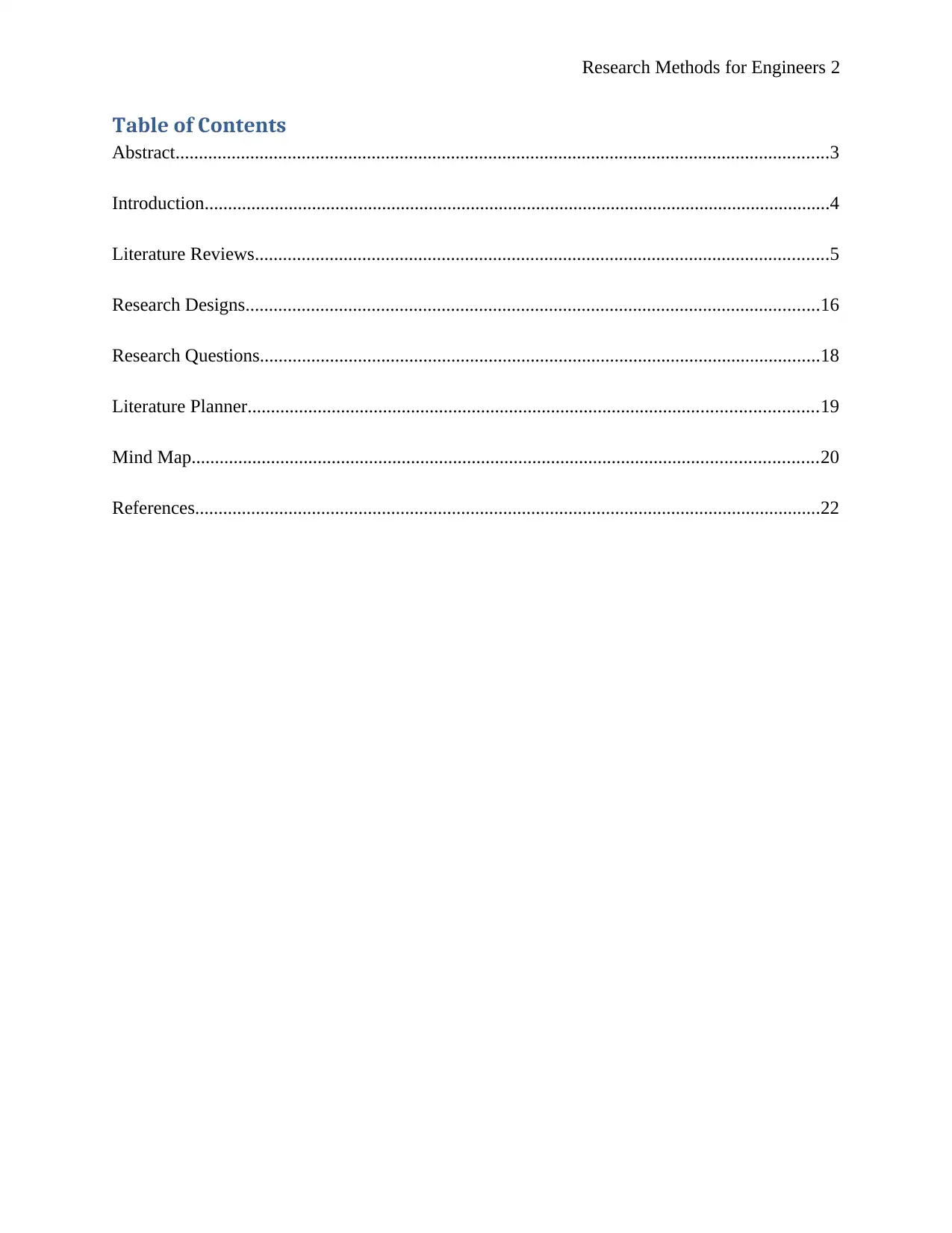
Research Methods for Engineers 2
Table of Contents
Abstract............................................................................................................................................3
Introduction......................................................................................................................................4
Literature Reviews...........................................................................................................................5
Research Designs...........................................................................................................................16
Research Questions........................................................................................................................18
Literature Planner..........................................................................................................................19
Mind Map......................................................................................................................................20
References......................................................................................................................................22
Table of Contents
Abstract............................................................................................................................................3
Introduction......................................................................................................................................4
Literature Reviews...........................................................................................................................5
Research Designs...........................................................................................................................16
Research Questions........................................................................................................................18
Literature Planner..........................................................................................................................19
Mind Map......................................................................................................................................20
References......................................................................................................................................22
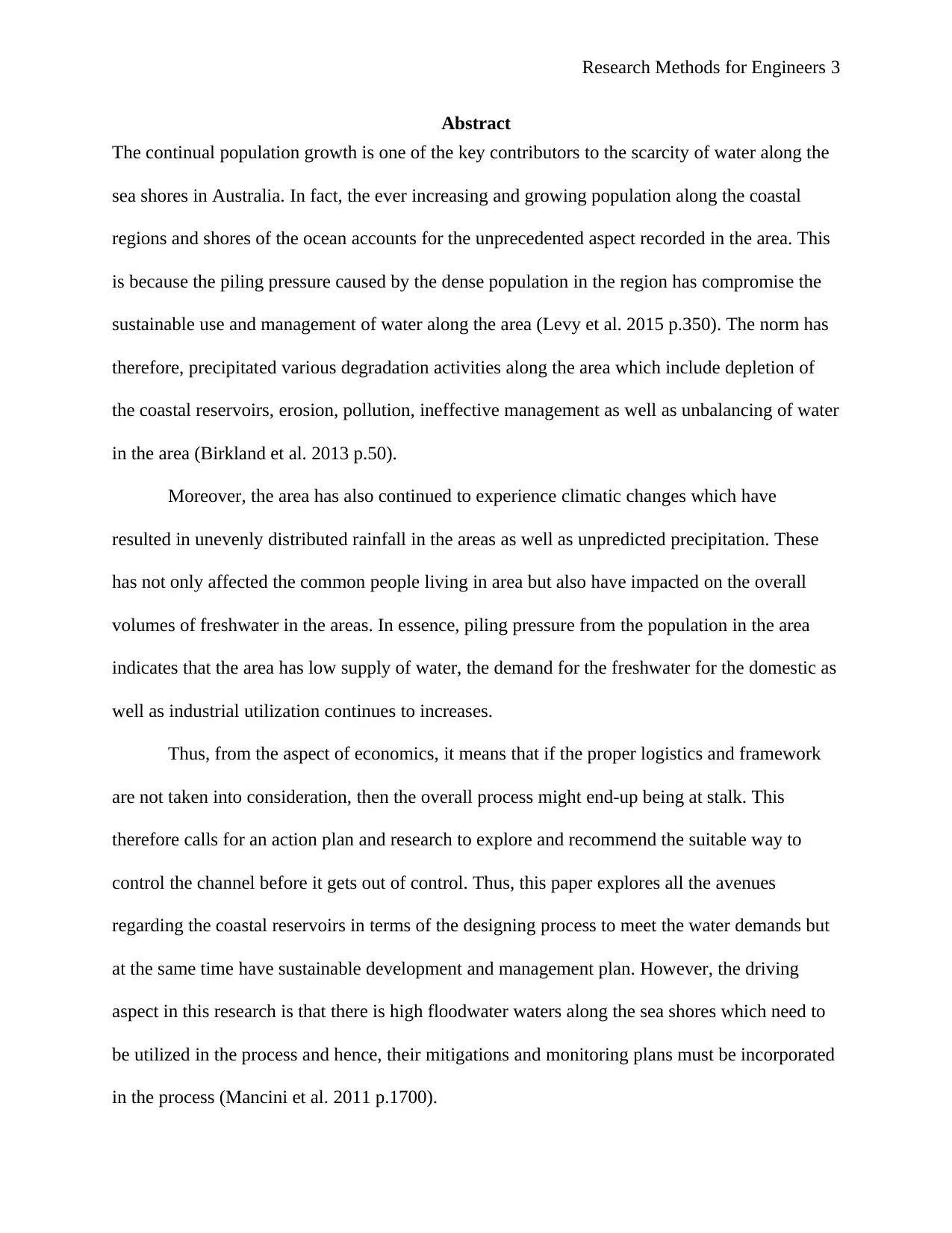
Research Methods for Engineers 3
Abstract
The continual population growth is one of the key contributors to the scarcity of water along the
sea shores in Australia. In fact, the ever increasing and growing population along the coastal
regions and shores of the ocean accounts for the unprecedented aspect recorded in the area. This
is because the piling pressure caused by the dense population in the region has compromise the
sustainable use and management of water along the area (Levy et al. 2015 p.350). The norm has
therefore, precipitated various degradation activities along the area which include depletion of
the coastal reservoirs, erosion, pollution, ineffective management as well as unbalancing of water
in the area (Birkland et al. 2013 p.50).
Moreover, the area has also continued to experience climatic changes which have
resulted in unevenly distributed rainfall in the areas as well as unpredicted precipitation. These
has not only affected the common people living in area but also have impacted on the overall
volumes of freshwater in the areas. In essence, piling pressure from the population in the area
indicates that the area has low supply of water, the demand for the freshwater for the domestic as
well as industrial utilization continues to increases.
Thus, from the aspect of economics, it means that if the proper logistics and framework
are not taken into consideration, then the overall process might end-up being at stalk. This
therefore calls for an action plan and research to explore and recommend the suitable way to
control the channel before it gets out of control. Thus, this paper explores all the avenues
regarding the coastal reservoirs in terms of the designing process to meet the water demands but
at the same time have sustainable development and management plan. However, the driving
aspect in this research is that there is high floodwater waters along the sea shores which need to
be utilized in the process and hence, their mitigations and monitoring plans must be incorporated
in the process (Mancini et al. 2011 p.1700).
Abstract
The continual population growth is one of the key contributors to the scarcity of water along the
sea shores in Australia. In fact, the ever increasing and growing population along the coastal
regions and shores of the ocean accounts for the unprecedented aspect recorded in the area. This
is because the piling pressure caused by the dense population in the region has compromise the
sustainable use and management of water along the area (Levy et al. 2015 p.350). The norm has
therefore, precipitated various degradation activities along the area which include depletion of
the coastal reservoirs, erosion, pollution, ineffective management as well as unbalancing of water
in the area (Birkland et al. 2013 p.50).
Moreover, the area has also continued to experience climatic changes which have
resulted in unevenly distributed rainfall in the areas as well as unpredicted precipitation. These
has not only affected the common people living in area but also have impacted on the overall
volumes of freshwater in the areas. In essence, piling pressure from the population in the area
indicates that the area has low supply of water, the demand for the freshwater for the domestic as
well as industrial utilization continues to increases.
Thus, from the aspect of economics, it means that if the proper logistics and framework
are not taken into consideration, then the overall process might end-up being at stalk. This
therefore calls for an action plan and research to explore and recommend the suitable way to
control the channel before it gets out of control. Thus, this paper explores all the avenues
regarding the coastal reservoirs in terms of the designing process to meet the water demands but
at the same time have sustainable development and management plan. However, the driving
aspect in this research is that there is high floodwater waters along the sea shores which need to
be utilized in the process and hence, their mitigations and monitoring plans must be incorporated
in the process (Mancini et al. 2011 p.1700).
⊘ This is a preview!⊘
Do you want full access?
Subscribe today to unlock all pages.

Trusted by 1+ million students worldwide
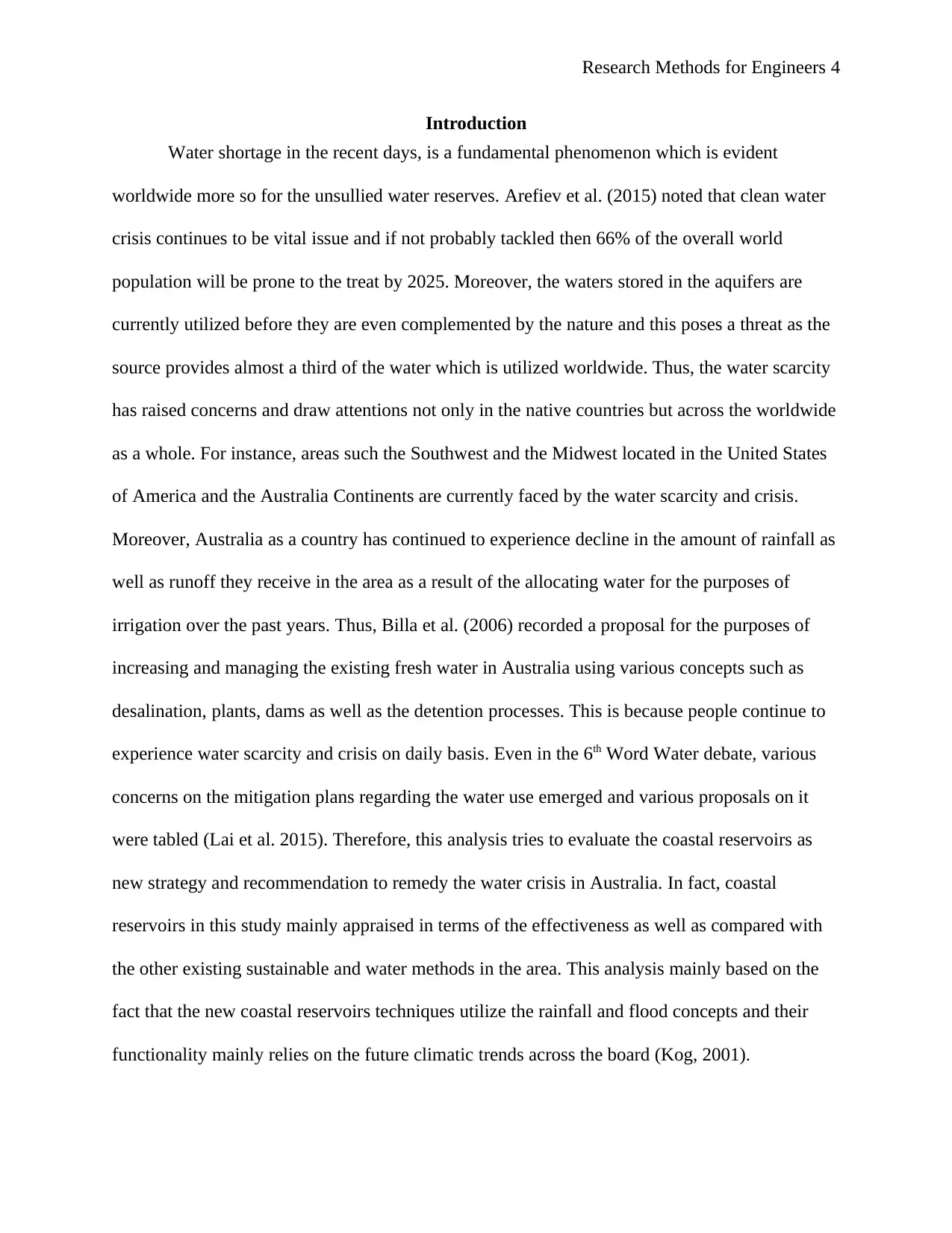
Research Methods for Engineers 4
Introduction
Water shortage in the recent days, is a fundamental phenomenon which is evident
worldwide more so for the unsullied water reserves. Arefiev et al. (2015) noted that clean water
crisis continues to be vital issue and if not probably tackled then 66% of the overall world
population will be prone to the treat by 2025. Moreover, the waters stored in the aquifers are
currently utilized before they are even complemented by the nature and this poses a threat as the
source provides almost a third of the water which is utilized worldwide. Thus, the water scarcity
has raised concerns and draw attentions not only in the native countries but across the worldwide
as a whole. For instance, areas such the Southwest and the Midwest located in the United States
of America and the Australia Continents are currently faced by the water scarcity and crisis.
Moreover, Australia as a country has continued to experience decline in the amount of rainfall as
well as runoff they receive in the area as a result of the allocating water for the purposes of
irrigation over the past years. Thus, Billa et al. (2006) recorded a proposal for the purposes of
increasing and managing the existing fresh water in Australia using various concepts such as
desalination, plants, dams as well as the detention processes. This is because people continue to
experience water scarcity and crisis on daily basis. Even in the 6th Word Water debate, various
concerns on the mitigation plans regarding the water use emerged and various proposals on it
were tabled (Lai et al. 2015). Therefore, this analysis tries to evaluate the coastal reservoirs as
new strategy and recommendation to remedy the water crisis in Australia. In fact, coastal
reservoirs in this study mainly appraised in terms of the effectiveness as well as compared with
the other existing sustainable and water methods in the area. This analysis mainly based on the
fact that the new coastal reservoirs techniques utilize the rainfall and flood concepts and their
functionality mainly relies on the future climatic trends across the board (Kog, 2001).
Introduction
Water shortage in the recent days, is a fundamental phenomenon which is evident
worldwide more so for the unsullied water reserves. Arefiev et al. (2015) noted that clean water
crisis continues to be vital issue and if not probably tackled then 66% of the overall world
population will be prone to the treat by 2025. Moreover, the waters stored in the aquifers are
currently utilized before they are even complemented by the nature and this poses a threat as the
source provides almost a third of the water which is utilized worldwide. Thus, the water scarcity
has raised concerns and draw attentions not only in the native countries but across the worldwide
as a whole. For instance, areas such the Southwest and the Midwest located in the United States
of America and the Australia Continents are currently faced by the water scarcity and crisis.
Moreover, Australia as a country has continued to experience decline in the amount of rainfall as
well as runoff they receive in the area as a result of the allocating water for the purposes of
irrigation over the past years. Thus, Billa et al. (2006) recorded a proposal for the purposes of
increasing and managing the existing fresh water in Australia using various concepts such as
desalination, plants, dams as well as the detention processes. This is because people continue to
experience water scarcity and crisis on daily basis. Even in the 6th Word Water debate, various
concerns on the mitigation plans regarding the water use emerged and various proposals on it
were tabled (Lai et al. 2015). Therefore, this analysis tries to evaluate the coastal reservoirs as
new strategy and recommendation to remedy the water crisis in Australia. In fact, coastal
reservoirs in this study mainly appraised in terms of the effectiveness as well as compared with
the other existing sustainable and water methods in the area. This analysis mainly based on the
fact that the new coastal reservoirs techniques utilize the rainfall and flood concepts and their
functionality mainly relies on the future climatic trends across the board (Kog, 2001).
Paraphrase This Document
Need a fresh take? Get an instant paraphrase of this document with our AI Paraphraser
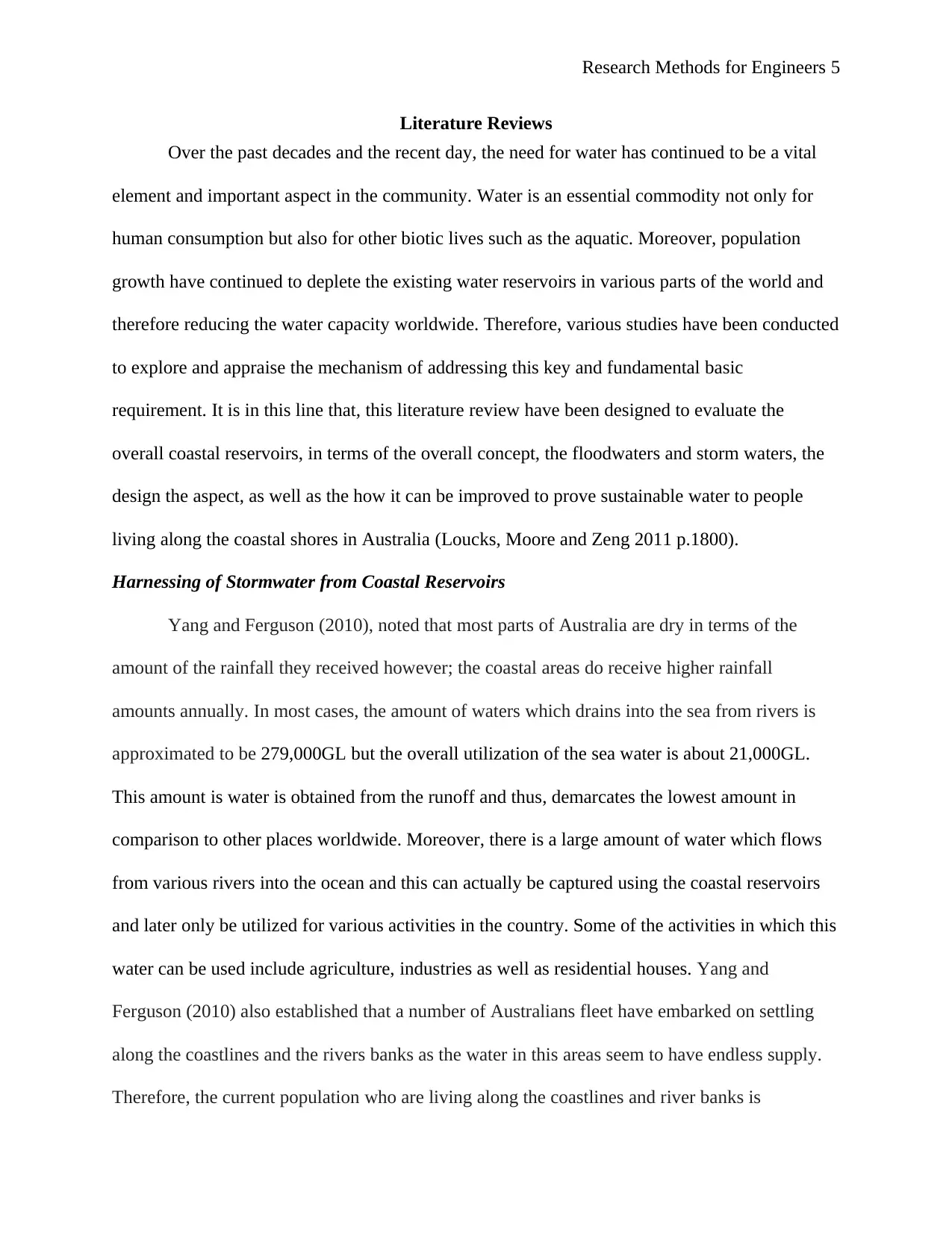
Research Methods for Engineers 5
Literature Reviews
Over the past decades and the recent day, the need for water has continued to be a vital
element and important aspect in the community. Water is an essential commodity not only for
human consumption but also for other biotic lives such as the aquatic. Moreover, population
growth have continued to deplete the existing water reservoirs in various parts of the world and
therefore reducing the water capacity worldwide. Therefore, various studies have been conducted
to explore and appraise the mechanism of addressing this key and fundamental basic
requirement. It is in this line that, this literature review have been designed to evaluate the
overall coastal reservoirs, in terms of the overall concept, the floodwaters and storm waters, the
design the aspect, as well as the how it can be improved to prove sustainable water to people
living along the coastal shores in Australia (Loucks, Moore and Zeng 2011 p.1800).
Harnessing of Stormwater from Coastal Reservoirs
Yang and Ferguson (2010), noted that most parts of Australia are dry in terms of the
amount of the rainfall they received however; the coastal areas do receive higher rainfall
amounts annually. In most cases, the amount of waters which drains into the sea from rivers is
approximated to be 279,000GL but the overall utilization of the sea water is about 21,000GL.
This amount is water is obtained from the runoff and thus, demarcates the lowest amount in
comparison to other places worldwide. Moreover, there is a large amount of water which flows
from various rivers into the ocean and this can actually be captured using the coastal reservoirs
and later only be utilized for various activities in the country. Some of the activities in which this
water can be used include agriculture, industries as well as residential houses. Yang and
Ferguson (2010) also established that a number of Australians fleet have embarked on settling
along the coastlines and the rivers banks as the water in this areas seem to have endless supply.
Therefore, the current population who are living along the coastlines and river banks is
Literature Reviews
Over the past decades and the recent day, the need for water has continued to be a vital
element and important aspect in the community. Water is an essential commodity not only for
human consumption but also for other biotic lives such as the aquatic. Moreover, population
growth have continued to deplete the existing water reservoirs in various parts of the world and
therefore reducing the water capacity worldwide. Therefore, various studies have been conducted
to explore and appraise the mechanism of addressing this key and fundamental basic
requirement. It is in this line that, this literature review have been designed to evaluate the
overall coastal reservoirs, in terms of the overall concept, the floodwaters and storm waters, the
design the aspect, as well as the how it can be improved to prove sustainable water to people
living along the coastal shores in Australia (Loucks, Moore and Zeng 2011 p.1800).
Harnessing of Stormwater from Coastal Reservoirs
Yang and Ferguson (2010), noted that most parts of Australia are dry in terms of the
amount of the rainfall they received however; the coastal areas do receive higher rainfall
amounts annually. In most cases, the amount of waters which drains into the sea from rivers is
approximated to be 279,000GL but the overall utilization of the sea water is about 21,000GL.
This amount is water is obtained from the runoff and thus, demarcates the lowest amount in
comparison to other places worldwide. Moreover, there is a large amount of water which flows
from various rivers into the ocean and this can actually be captured using the coastal reservoirs
and later only be utilized for various activities in the country. Some of the activities in which this
water can be used include agriculture, industries as well as residential houses. Yang and
Ferguson (2010) also established that a number of Australians fleet have embarked on settling
along the coastlines and the rivers banks as the water in this areas seem to have endless supply.
Therefore, the current population who are living along the coastlines and river banks is
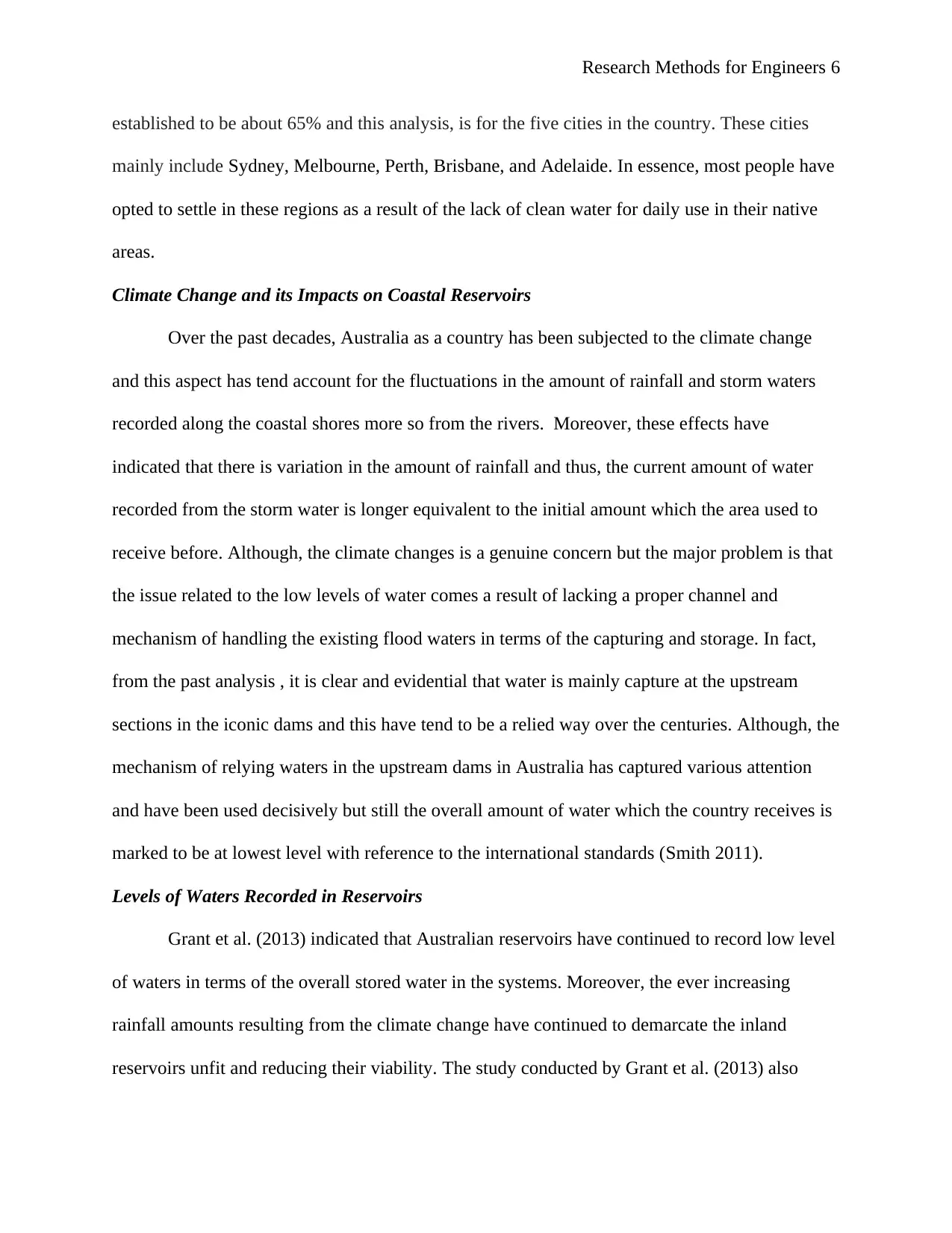
Research Methods for Engineers 6
established to be about 65% and this analysis, is for the five cities in the country. These cities
mainly include Sydney, Melbourne, Perth, Brisbane, and Adelaide. In essence, most people have
opted to settle in these regions as a result of the lack of clean water for daily use in their native
areas.
Climate Change and its Impacts on Coastal Reservoirs
Over the past decades, Australia as a country has been subjected to the climate change
and this aspect has tend account for the fluctuations in the amount of rainfall and storm waters
recorded along the coastal shores more so from the rivers. Moreover, these effects have
indicated that there is variation in the amount of rainfall and thus, the current amount of water
recorded from the storm water is longer equivalent to the initial amount which the area used to
receive before. Although, the climate changes is a genuine concern but the major problem is that
the issue related to the low levels of water comes a result of lacking a proper channel and
mechanism of handling the existing flood waters in terms of the capturing and storage. In fact,
from the past analysis , it is clear and evidential that water is mainly capture at the upstream
sections in the iconic dams and this have tend to be a relied way over the centuries. Although, the
mechanism of relying waters in the upstream dams in Australia has captured various attention
and have been used decisively but still the overall amount of water which the country receives is
marked to be at lowest level with reference to the international standards (Smith 2011).
Levels of Waters Recorded in Reservoirs
Grant et al. (2013) indicated that Australian reservoirs have continued to record low level
of waters in terms of the overall stored water in the systems. Moreover, the ever increasing
rainfall amounts resulting from the climate change have continued to demarcate the inland
reservoirs unfit and reducing their viability. The study conducted by Grant et al. (2013) also
established to be about 65% and this analysis, is for the five cities in the country. These cities
mainly include Sydney, Melbourne, Perth, Brisbane, and Adelaide. In essence, most people have
opted to settle in these regions as a result of the lack of clean water for daily use in their native
areas.
Climate Change and its Impacts on Coastal Reservoirs
Over the past decades, Australia as a country has been subjected to the climate change
and this aspect has tend account for the fluctuations in the amount of rainfall and storm waters
recorded along the coastal shores more so from the rivers. Moreover, these effects have
indicated that there is variation in the amount of rainfall and thus, the current amount of water
recorded from the storm water is longer equivalent to the initial amount which the area used to
receive before. Although, the climate changes is a genuine concern but the major problem is that
the issue related to the low levels of water comes a result of lacking a proper channel and
mechanism of handling the existing flood waters in terms of the capturing and storage. In fact,
from the past analysis , it is clear and evidential that water is mainly capture at the upstream
sections in the iconic dams and this have tend to be a relied way over the centuries. Although, the
mechanism of relying waters in the upstream dams in Australia has captured various attention
and have been used decisively but still the overall amount of water which the country receives is
marked to be at lowest level with reference to the international standards (Smith 2011).
Levels of Waters Recorded in Reservoirs
Grant et al. (2013) indicated that Australian reservoirs have continued to record low level
of waters in terms of the overall stored water in the systems. Moreover, the ever increasing
rainfall amounts resulting from the climate change have continued to demarcate the inland
reservoirs unfit and reducing their viability. The study conducted by Grant et al. (2013) also
⊘ This is a preview!⊘
Do you want full access?
Subscribe today to unlock all pages.

Trusted by 1+ million students worldwide
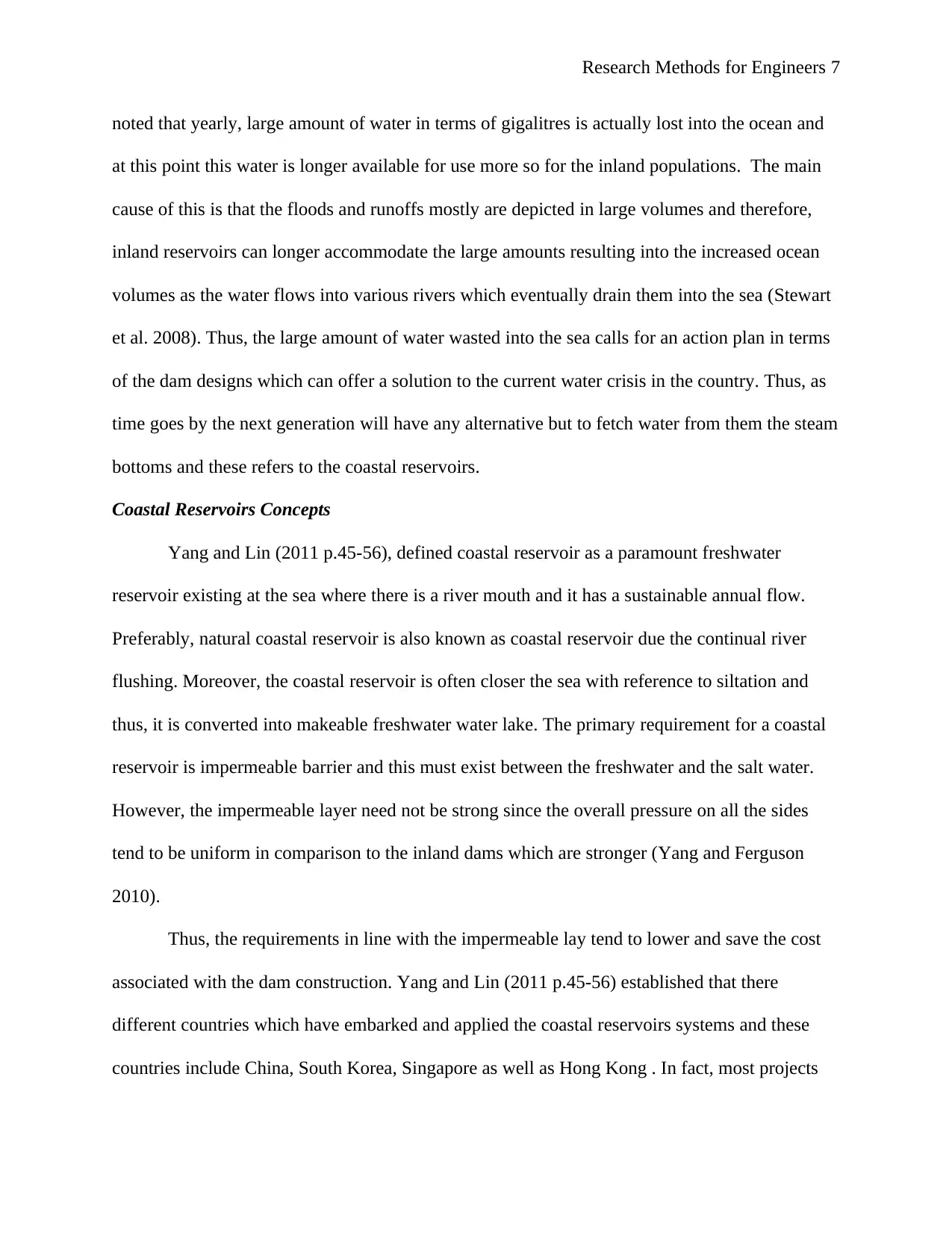
Research Methods for Engineers 7
noted that yearly, large amount of water in terms of gigalitres is actually lost into the ocean and
at this point this water is longer available for use more so for the inland populations. The main
cause of this is that the floods and runoffs mostly are depicted in large volumes and therefore,
inland reservoirs can longer accommodate the large amounts resulting into the increased ocean
volumes as the water flows into various rivers which eventually drain them into the sea (Stewart
et al. 2008). Thus, the large amount of water wasted into the sea calls for an action plan in terms
of the dam designs which can offer a solution to the current water crisis in the country. Thus, as
time goes by the next generation will have any alternative but to fetch water from them the steam
bottoms and these refers to the coastal reservoirs.
Coastal Reservoirs Concepts
Yang and Lin (2011 p.45-56), defined coastal reservoir as a paramount freshwater
reservoir existing at the sea where there is a river mouth and it has a sustainable annual flow.
Preferably, natural coastal reservoir is also known as coastal reservoir due the continual river
flushing. Moreover, the coastal reservoir is often closer the sea with reference to siltation and
thus, it is converted into makeable freshwater water lake. The primary requirement for a coastal
reservoir is impermeable barrier and this must exist between the freshwater and the salt water.
However, the impermeable layer need not be strong since the overall pressure on all the sides
tend to be uniform in comparison to the inland dams which are stronger (Yang and Ferguson
2010).
Thus, the requirements in line with the impermeable lay tend to lower and save the cost
associated with the dam construction. Yang and Lin (2011 p.45-56) established that there
different countries which have embarked and applied the coastal reservoirs systems and these
countries include China, South Korea, Singapore as well as Hong Kong . In fact, most projects
noted that yearly, large amount of water in terms of gigalitres is actually lost into the ocean and
at this point this water is longer available for use more so for the inland populations. The main
cause of this is that the floods and runoffs mostly are depicted in large volumes and therefore,
inland reservoirs can longer accommodate the large amounts resulting into the increased ocean
volumes as the water flows into various rivers which eventually drain them into the sea (Stewart
et al. 2008). Thus, the large amount of water wasted into the sea calls for an action plan in terms
of the dam designs which can offer a solution to the current water crisis in the country. Thus, as
time goes by the next generation will have any alternative but to fetch water from them the steam
bottoms and these refers to the coastal reservoirs.
Coastal Reservoirs Concepts
Yang and Lin (2011 p.45-56), defined coastal reservoir as a paramount freshwater
reservoir existing at the sea where there is a river mouth and it has a sustainable annual flow.
Preferably, natural coastal reservoir is also known as coastal reservoir due the continual river
flushing. Moreover, the coastal reservoir is often closer the sea with reference to siltation and
thus, it is converted into makeable freshwater water lake. The primary requirement for a coastal
reservoir is impermeable barrier and this must exist between the freshwater and the salt water.
However, the impermeable layer need not be strong since the overall pressure on all the sides
tend to be uniform in comparison to the inland dams which are stronger (Yang and Ferguson
2010).
Thus, the requirements in line with the impermeable lay tend to lower and save the cost
associated with the dam construction. Yang and Lin (2011 p.45-56) established that there
different countries which have embarked and applied the coastal reservoirs systems and these
countries include China, South Korea, Singapore as well as Hong Kong . In fact, most projects
Paraphrase This Document
Need a fresh take? Get an instant paraphrase of this document with our AI Paraphraser
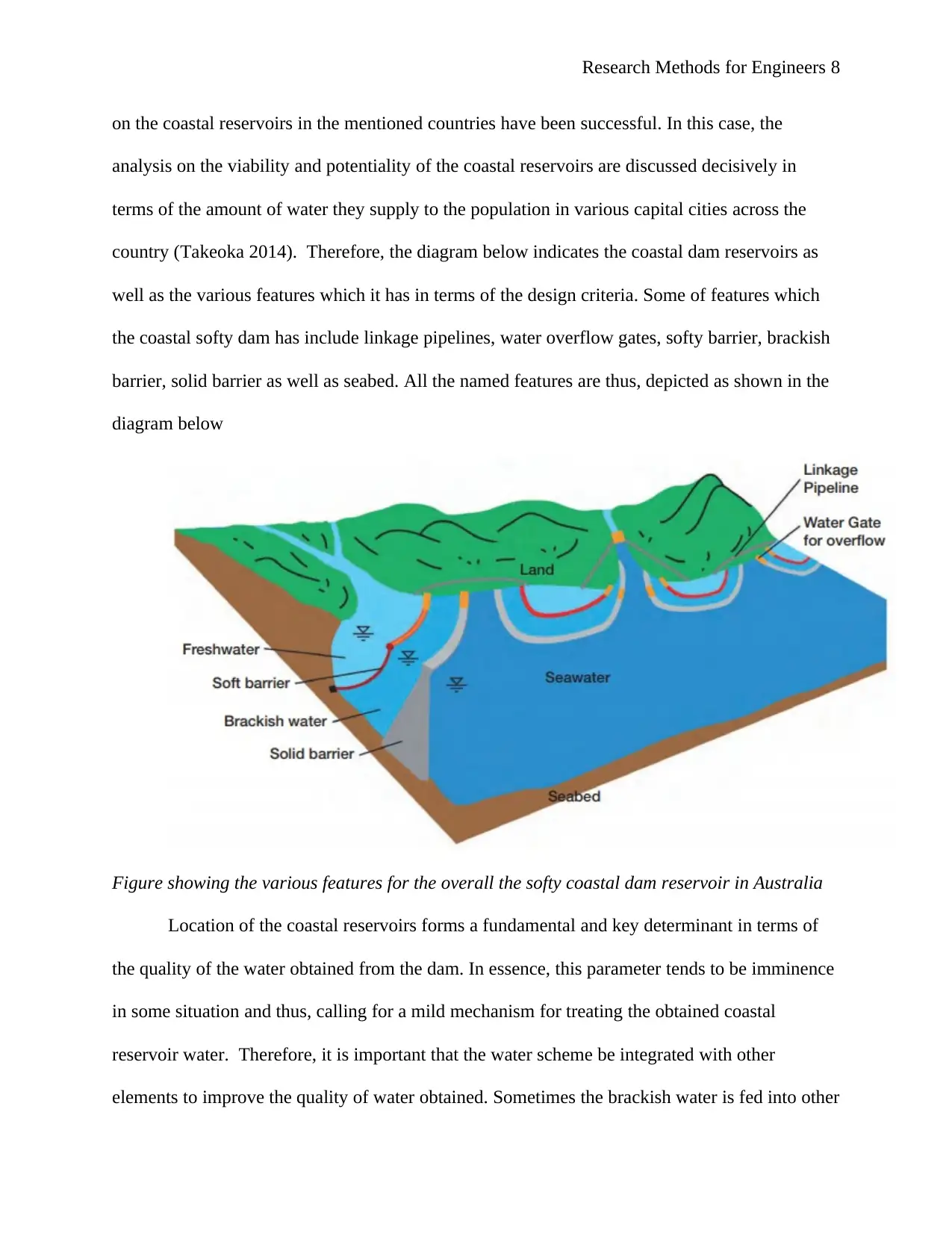
Research Methods for Engineers 8
on the coastal reservoirs in the mentioned countries have been successful. In this case, the
analysis on the viability and potentiality of the coastal reservoirs are discussed decisively in
terms of the amount of water they supply to the population in various capital cities across the
country (Takeoka 2014). Therefore, the diagram below indicates the coastal dam reservoirs as
well as the various features which it has in terms of the design criteria. Some of features which
the coastal softy dam has include linkage pipelines, water overflow gates, softy barrier, brackish
barrier, solid barrier as well as seabed. All the named features are thus, depicted as shown in the
diagram below
Figure showing the various features for the overall the softy coastal dam reservoir in Australia
Location of the coastal reservoirs forms a fundamental and key determinant in terms of
the quality of the water obtained from the dam. In essence, this parameter tends to be imminence
in some situation and thus, calling for a mild mechanism for treating the obtained coastal
reservoir water. Therefore, it is important that the water scheme be integrated with other
elements to improve the quality of water obtained. Sometimes the brackish water is fed into other
on the coastal reservoirs in the mentioned countries have been successful. In this case, the
analysis on the viability and potentiality of the coastal reservoirs are discussed decisively in
terms of the amount of water they supply to the population in various capital cities across the
country (Takeoka 2014). Therefore, the diagram below indicates the coastal dam reservoirs as
well as the various features which it has in terms of the design criteria. Some of features which
the coastal softy dam has include linkage pipelines, water overflow gates, softy barrier, brackish
barrier, solid barrier as well as seabed. All the named features are thus, depicted as shown in the
diagram below
Figure showing the various features for the overall the softy coastal dam reservoir in Australia
Location of the coastal reservoirs forms a fundamental and key determinant in terms of
the quality of the water obtained from the dam. In essence, this parameter tends to be imminence
in some situation and thus, calling for a mild mechanism for treating the obtained coastal
reservoir water. Therefore, it is important that the water scheme be integrated with other
elements to improve the quality of water obtained. Sometimes the brackish water is fed into other
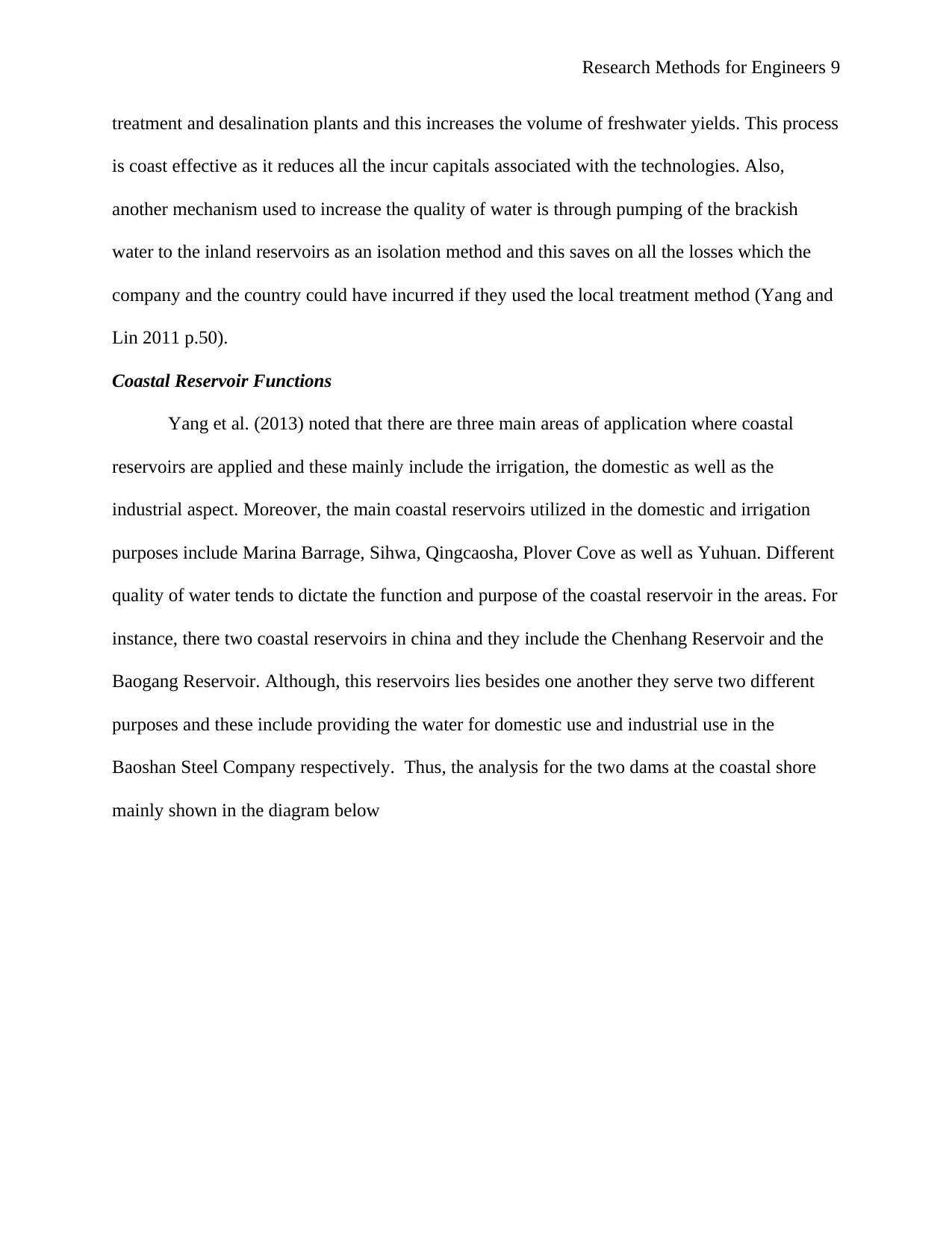
Research Methods for Engineers 9
treatment and desalination plants and this increases the volume of freshwater yields. This process
is coast effective as it reduces all the incur capitals associated with the technologies. Also,
another mechanism used to increase the quality of water is through pumping of the brackish
water to the inland reservoirs as an isolation method and this saves on all the losses which the
company and the country could have incurred if they used the local treatment method (Yang and
Lin 2011 p.50).
Coastal Reservoir Functions
Yang et al. (2013) noted that there are three main areas of application where coastal
reservoirs are applied and these mainly include the irrigation, the domestic as well as the
industrial aspect. Moreover, the main coastal reservoirs utilized in the domestic and irrigation
purposes include Marina Barrage, Sihwa, Qingcaosha, Plover Cove as well as Yuhuan. Different
quality of water tends to dictate the function and purpose of the coastal reservoir in the areas. For
instance, there two coastal reservoirs in china and they include the Chenhang Reservoir and the
Baogang Reservoir. Although, this reservoirs lies besides one another they serve two different
purposes and these include providing the water for domestic use and industrial use in the
Baoshan Steel Company respectively. Thus, the analysis for the two dams at the coastal shore
mainly shown in the diagram below
treatment and desalination plants and this increases the volume of freshwater yields. This process
is coast effective as it reduces all the incur capitals associated with the technologies. Also,
another mechanism used to increase the quality of water is through pumping of the brackish
water to the inland reservoirs as an isolation method and this saves on all the losses which the
company and the country could have incurred if they used the local treatment method (Yang and
Lin 2011 p.50).
Coastal Reservoir Functions
Yang et al. (2013) noted that there are three main areas of application where coastal
reservoirs are applied and these mainly include the irrigation, the domestic as well as the
industrial aspect. Moreover, the main coastal reservoirs utilized in the domestic and irrigation
purposes include Marina Barrage, Sihwa, Qingcaosha, Plover Cove as well as Yuhuan. Different
quality of water tends to dictate the function and purpose of the coastal reservoir in the areas. For
instance, there two coastal reservoirs in china and they include the Chenhang Reservoir and the
Baogang Reservoir. Although, this reservoirs lies besides one another they serve two different
purposes and these include providing the water for domestic use and industrial use in the
Baoshan Steel Company respectively. Thus, the analysis for the two dams at the coastal shore
mainly shown in the diagram below
⊘ This is a preview!⊘
Do you want full access?
Subscribe today to unlock all pages.

Trusted by 1+ million students worldwide
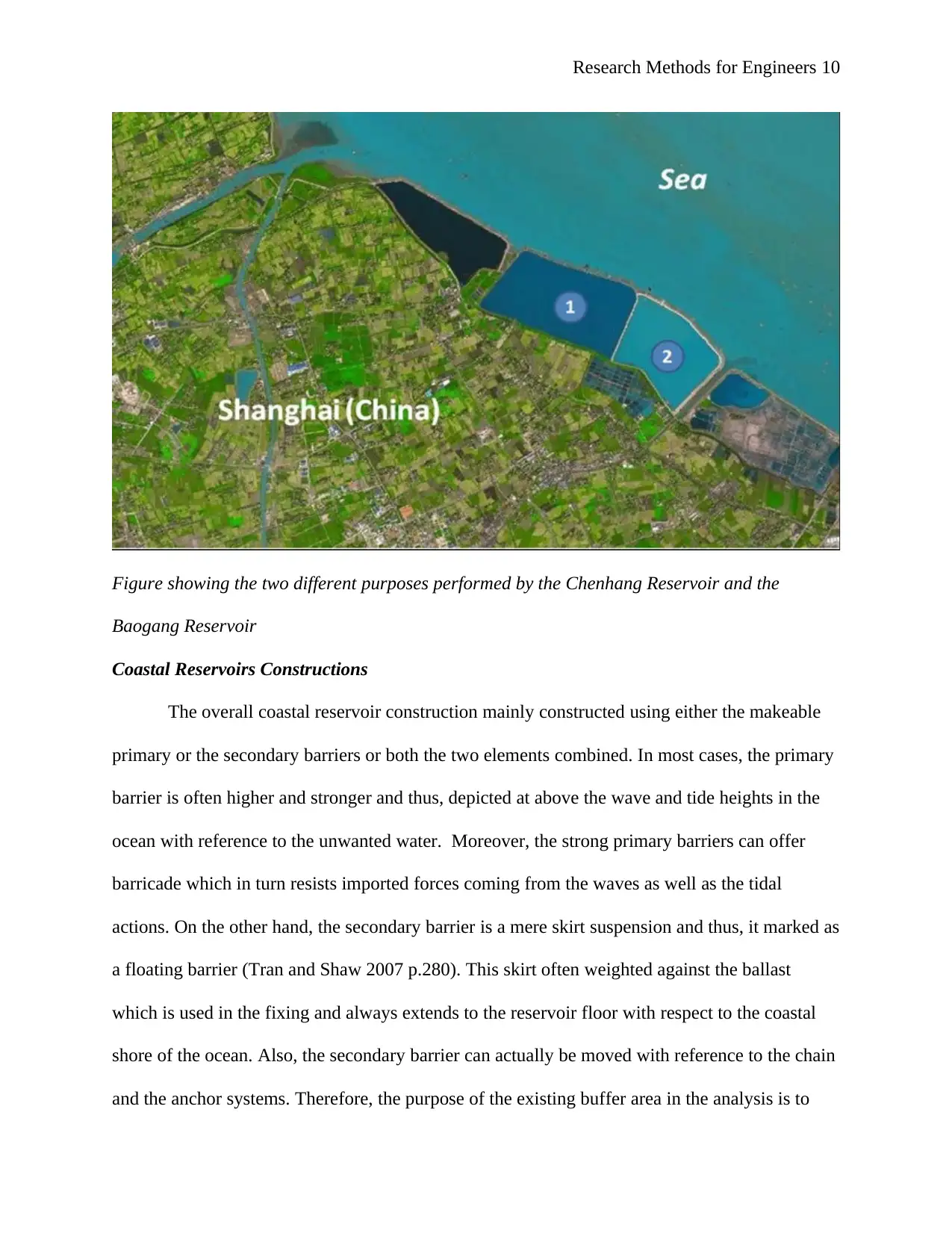
Research Methods for Engineers 10
Figure showing the two different purposes performed by the Chenhang Reservoir and the
Baogang Reservoir
Coastal Reservoirs Constructions
The overall coastal reservoir construction mainly constructed using either the makeable
primary or the secondary barriers or both the two elements combined. In most cases, the primary
barrier is often higher and stronger and thus, depicted at above the wave and tide heights in the
ocean with reference to the unwanted water. Moreover, the strong primary barriers can offer
barricade which in turn resists imported forces coming from the waves as well as the tidal
actions. On the other hand, the secondary barrier is a mere skirt suspension and thus, it marked as
a floating barrier (Tran and Shaw 2007 p.280). This skirt often weighted against the ballast
which is used in the fixing and always extends to the reservoir floor with respect to the coastal
shore of the ocean. Also, the secondary barrier can actually be moved with reference to the chain
and the anchor systems. Therefore, the purpose of the existing buffer area in the analysis is to
Figure showing the two different purposes performed by the Chenhang Reservoir and the
Baogang Reservoir
Coastal Reservoirs Constructions
The overall coastal reservoir construction mainly constructed using either the makeable
primary or the secondary barriers or both the two elements combined. In most cases, the primary
barrier is often higher and stronger and thus, depicted at above the wave and tide heights in the
ocean with reference to the unwanted water. Moreover, the strong primary barriers can offer
barricade which in turn resists imported forces coming from the waves as well as the tidal
actions. On the other hand, the secondary barrier is a mere skirt suspension and thus, it marked as
a floating barrier (Tran and Shaw 2007 p.280). This skirt often weighted against the ballast
which is used in the fixing and always extends to the reservoir floor with respect to the coastal
shore of the ocean. Also, the secondary barrier can actually be moved with reference to the chain
and the anchor systems. Therefore, the purpose of the existing buffer area in the analysis is to
Paraphrase This Document
Need a fresh take? Get an instant paraphrase of this document with our AI Paraphraser
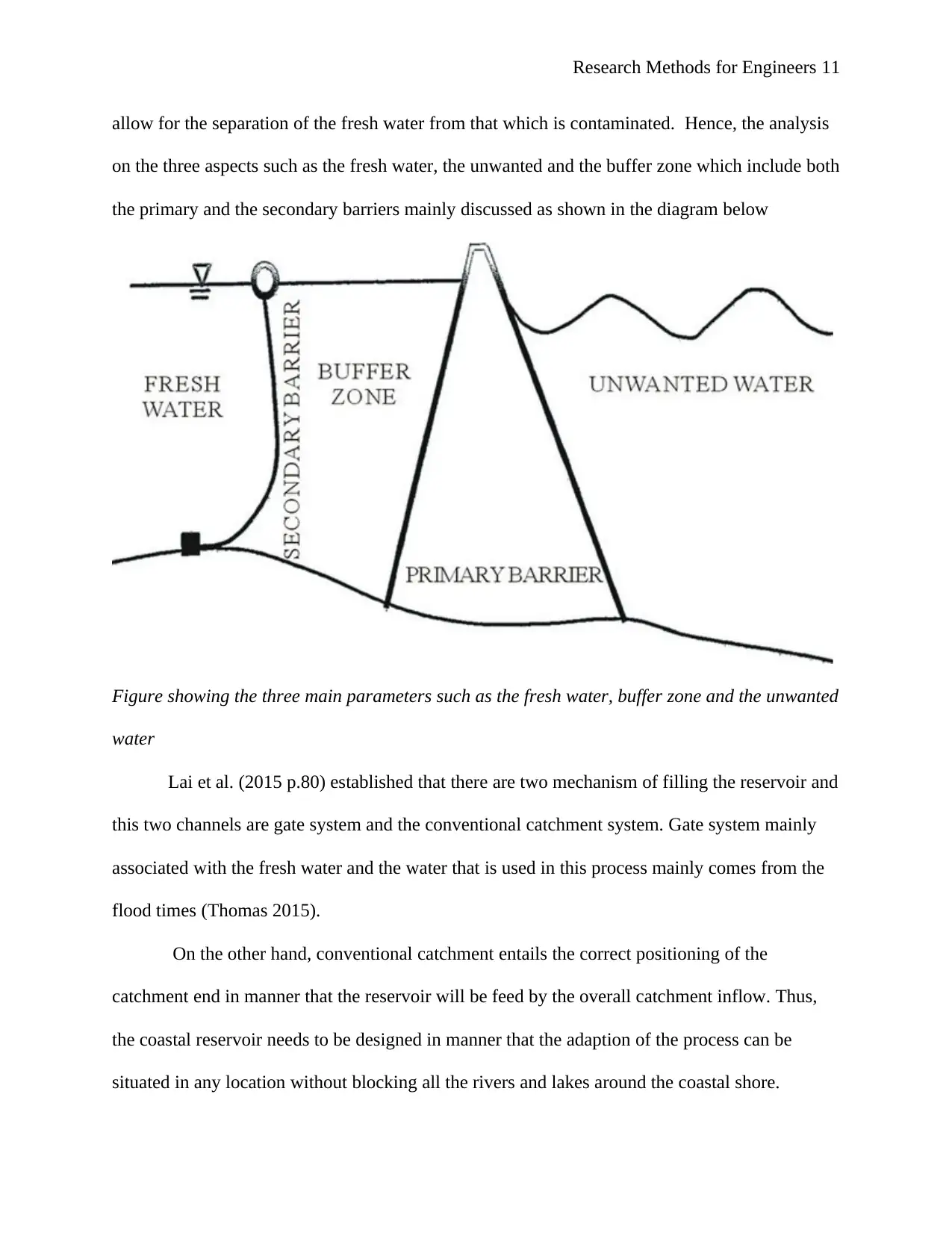
Research Methods for Engineers 11
allow for the separation of the fresh water from that which is contaminated. Hence, the analysis
on the three aspects such as the fresh water, the unwanted and the buffer zone which include both
the primary and the secondary barriers mainly discussed as shown in the diagram below
Figure showing the three main parameters such as the fresh water, buffer zone and the unwanted
water
Lai et al. (2015 p.80) established that there are two mechanism of filling the reservoir and
this two channels are gate system and the conventional catchment system. Gate system mainly
associated with the fresh water and the water that is used in this process mainly comes from the
flood times (Thomas 2015).
On the other hand, conventional catchment entails the correct positioning of the
catchment end in manner that the reservoir will be feed by the overall catchment inflow. Thus,
the coastal reservoir needs to be designed in manner that the adaption of the process can be
situated in any location without blocking all the rivers and lakes around the coastal shore.
allow for the separation of the fresh water from that which is contaminated. Hence, the analysis
on the three aspects such as the fresh water, the unwanted and the buffer zone which include both
the primary and the secondary barriers mainly discussed as shown in the diagram below
Figure showing the three main parameters such as the fresh water, buffer zone and the unwanted
water
Lai et al. (2015 p.80) established that there are two mechanism of filling the reservoir and
this two channels are gate system and the conventional catchment system. Gate system mainly
associated with the fresh water and the water that is used in this process mainly comes from the
flood times (Thomas 2015).
On the other hand, conventional catchment entails the correct positioning of the
catchment end in manner that the reservoir will be feed by the overall catchment inflow. Thus,
the coastal reservoir needs to be designed in manner that the adaption of the process can be
situated in any location without blocking all the rivers and lakes around the coastal shore.
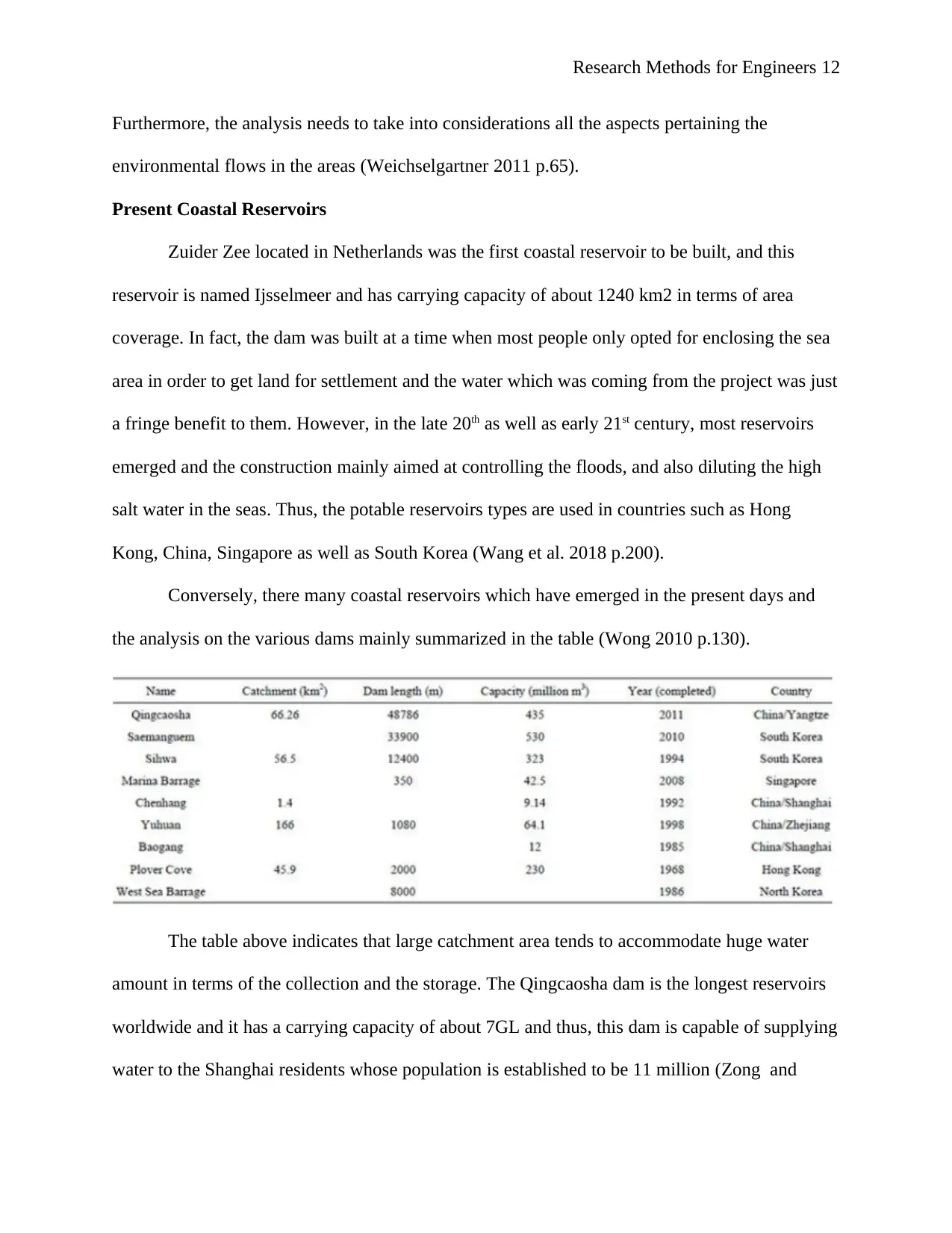
Research Methods for Engineers 12
Furthermore, the analysis needs to take into considerations all the aspects pertaining the
environmental flows in the areas (Weichselgartner 2011 p.65).
Present Coastal Reservoirs
Zuider Zee located in Netherlands was the first coastal reservoir to be built, and this
reservoir is named Ijsselmeer and has carrying capacity of about 1240 km2 in terms of area
coverage. In fact, the dam was built at a time when most people only opted for enclosing the sea
area in order to get land for settlement and the water which was coming from the project was just
a fringe benefit to them. However, in the late 20th as well as early 21st century, most reservoirs
emerged and the construction mainly aimed at controlling the floods, and also diluting the high
salt water in the seas. Thus, the potable reservoirs types are used in countries such as Hong
Kong, China, Singapore as well as South Korea (Wang et al. 2018 p.200).
Conversely, there many coastal reservoirs which have emerged in the present days and
the analysis on the various dams mainly summarized in the table (Wong 2010 p.130).
The table above indicates that large catchment area tends to accommodate huge water
amount in terms of the collection and the storage. The Qingcaosha dam is the longest reservoirs
worldwide and it has a carrying capacity of about 7GL and thus, this dam is capable of supplying
water to the Shanghai residents whose population is established to be 11 million (Zong and
Furthermore, the analysis needs to take into considerations all the aspects pertaining the
environmental flows in the areas (Weichselgartner 2011 p.65).
Present Coastal Reservoirs
Zuider Zee located in Netherlands was the first coastal reservoir to be built, and this
reservoir is named Ijsselmeer and has carrying capacity of about 1240 km2 in terms of area
coverage. In fact, the dam was built at a time when most people only opted for enclosing the sea
area in order to get land for settlement and the water which was coming from the project was just
a fringe benefit to them. However, in the late 20th as well as early 21st century, most reservoirs
emerged and the construction mainly aimed at controlling the floods, and also diluting the high
salt water in the seas. Thus, the potable reservoirs types are used in countries such as Hong
Kong, China, Singapore as well as South Korea (Wang et al. 2018 p.200).
Conversely, there many coastal reservoirs which have emerged in the present days and
the analysis on the various dams mainly summarized in the table (Wong 2010 p.130).
The table above indicates that large catchment area tends to accommodate huge water
amount in terms of the collection and the storage. The Qingcaosha dam is the longest reservoirs
worldwide and it has a carrying capacity of about 7GL and thus, this dam is capable of supplying
water to the Shanghai residents whose population is established to be 11 million (Zong and
⊘ This is a preview!⊘
Do you want full access?
Subscribe today to unlock all pages.

Trusted by 1+ million students worldwide
1 out of 26
Your All-in-One AI-Powered Toolkit for Academic Success.
+13062052269
info@desklib.com
Available 24*7 on WhatsApp / Email
![[object Object]](/_next/static/media/star-bottom.7253800d.svg)
Unlock your academic potential
Copyright © 2020–2025 A2Z Services. All Rights Reserved. Developed and managed by ZUCOL.

